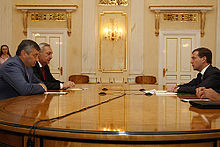Six point plan
The six-point plan ( Russian План Медведева-Саркози Plan Medvedeva-Sarkosi , German: Medvedev-Sarkozy Plan ) is a ceasefire plan for Georgia , South Ossetia and Abkhazia , which was designed to resolve the Caucasus conflict of 2008 . The plan was brokered by French President and President of the European Council , Nicolas Sarkozy , confirmed by EU foreign ministers on August 13, 2008, by South Ossetia and Abkhazia on August 14, by Georgia on August 15 and by Russia on August 16. August signed. The European Union Monitoring Mission in Georgia (EUMM) was commissioned with the monitoring .
content
The six-point plan provides:
- 1. A renunciation of the use of force.
- 2. The final cessation of all fighting.
- 3. Ensuring unhindered access to humanitarian aid.
- 4. A return of the Georgian armed forces to their original position.
- 5. A withdrawal of the Russian armed forces to the lines behind which they were before the fighting began. The Russian peacekeeping forces are to take additional security measures until international mechanisms are agreed.
- 6. The start of international talks on modalities for security and stability in South Ossetia and Abkhazia.
According to the Deputy Foreign Minister of Georgia, Giga Bokeria , the six-point plan includes a letter from Sarkozy that allows Russia to have a military presence outside of South Ossetia and Abkhazia as part of security measures. However, the letter states that the permit does not apply to inhabited areas and the east-west highway.
According to the UN Security Council, the plan also provides for the mandate of the United Nations Observer Mission in Georgia to continue as it was before August 7, 2008.
Open questions
A passage on the sovereignty and territorial integrity of Georgia is missing because, according to news agencies, it was rejected by the Russian government in the peace negotiations. According to the agency, Russia had also refused to limit the additional security measures mentioned in point 5 to six months and to take decisions of the UN and the OSCE as a basis in point 6 . There are no explicit statements about status issues.
Additional agreements
On September 8, 2008, after a meeting between Presidents Dmitri Medvedev and Nicolas Sarkozy , Russia committed to observing additional points. According to this, Russia is to withdraw its peacekeeping forces from five observation points on the Senaki - Poti line within seven days .
The complete withdrawal of Russian peacekeepers is expected to take place within ten days of the installation of international peacekeeping mechanisms. At least 200 EU observers are to be integrated into these mechanisms. These mechanisms should be in place by October 1, 2008 at the latest. Until then, the Georgian troops will have to withdraw to their pre-war locations.
The UN and OSCE observers are to resume their work in the numbers and locations in which they were active prior to August 7, 2008. Changes by the UN Security Council or the OSCE General Assembly are reserved. The European Union undertook to guarantee that Georgia will renounce violence .
The international discussion on the status of South Ossetia and Abkhazia is scheduled to begin on October 12, 2008 in Geneva . Ways to guarantee the security and stability of the region, solutions to the problem of refugees and any questions should be discussed by mutual agreement.
Web links
Individual evidence
- ↑ Заявления Exemples прессы и ответы на вопросы по журналистов итогам переговоров с Франции Президентом Николя Саркози. Press releases [by the President of the Russian Federation] and answers to questions from journalists after discussions with French President Nicolas Sarkozy. In: kremlin.ru. August 12, 2008, archived from the original on January 24, 2009 ; Retrieved January 19, 2019 (Russian).
